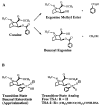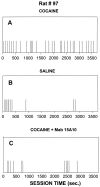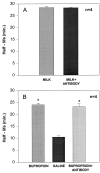A catalytic antibody against cocaine prevents cocaine's reinforcing and toxic effects in rats
- PMID: 9707620
- PMCID: PMC21481
- DOI: 10.1073/pnas.95.17.10176
A catalytic antibody against cocaine prevents cocaine's reinforcing and toxic effects in rats
Abstract
Cocaine addiction and overdose have long defied specific treatment. To provide a new approach, the high-activity catalytic antibody mAb 15A10 was elicited using a transition-state analog for the hydrolysis of cocaine to nontoxic, nonaddictive products. In a model of cocaine overdose, mAb 15A10 protected rats from cocaine-induced seizures and sudden death in a dose-dependent fashion; a noncatalytic anticocaine antibody did not reduce toxicity. Consistent with accelerated catalysis, the hydrolysis product ecgonine methyl ester was increased >10-fold in plasma of rats receiving mAb 15A10 and lethal amounts of cocaine. In a model of cocaine addiction, mAb 15A10 blocked completely the reinforcing effect of cocaine in rats. mAb 15A10 blocked cocaine specifically and did not affect behavior maintained by milk or by the dopamine reuptake inhibitor bupropion. This artificial cocaine esterase is a rationally designed cocaine antagonist and a catalytic antibody with potential for medicinal use.
Figures






Similar articles
-
Natural and artificial enzymes against cocaine. I. Monoclonal antibody 15A10 and the reinforcing effects of cocaine in rats.J Pharmacol Exp Ther. 2000 Dec;295(3):1127-34. J Pharmacol Exp Ther. 2000. PMID: 11082449
-
A catalytic antibody against cocaine attenuates cocaine's cardiovascular effects in mice: a dose and time course analysis.Int Immunopharmacol. 2001 Jun;1(6):1189-98. doi: 10.1016/s1567-5769(01)00054-6. Int Immunopharmacol. 2001. PMID: 11407313
-
Anticocaine catalytic antibodies.J Immunol Methods. 2002 Nov 1;269(1-2):299-310. doi: 10.1016/s0022-1759(02)00237-5. J Immunol Methods. 2002. PMID: 12379369 Review.
-
Anti-cocaine catalytic antibodies--a novel approach to the problem of addiction.J Addict Dis. 1997;16(3):1-17. doi: 10.1300/J069v16n03_01. J Addict Dis. 1997. PMID: 9243335 Review.
-
Application of artificial enzymes to the problem of cocaine.Ann N Y Acad Sci. 2000;909:159-69. doi: 10.1111/j.1749-6632.2000.tb06681.x. Ann N Y Acad Sci. 2000. PMID: 10911929 Review.
Cited by
-
Ethical Implications in Vaccine Pharmacotherapy for Treatment and Prevention of Drug of Abuse Dependence.J Bioeth Inq. 2018 Mar;15(1):45-55. doi: 10.1007/s11673-017-9834-5. Epub 2018 Jan 19. J Bioeth Inq. 2018. PMID: 29350320
-
A bacterial cocaine esterase protects against cocaine-induced epileptogenic activity and lethality.Ann Emerg Med. 2009 Sep;54(3):409-20. doi: 10.1016/j.annemergmed.2008.09.023. Epub 2008 Nov 14. Ann Emerg Med. 2009. PMID: 19013687 Free PMC article.
-
An active immunization approach to generate protective catalytic antibodies.Biochem J. 2001 Nov 15;360(Pt 1):151-7. doi: 10.1042/0264-6021:3600151. Biochem J. 2001. PMID: 11696002 Free PMC article.
-
Probing active cocaine vaccination performance through catalytic and noncatalytic hapten design.J Med Chem. 2013 May 9;56(9):3701-9. doi: 10.1021/jm400228w. Epub 2013 Apr 29. J Med Chem. 2013. PMID: 23627877 Free PMC article.
-
Computational design of a thermostable mutant of cocaine esterase via molecular dynamics simulations.Org Biomol Chem. 2011 Jun 7;9(11):4138-43. doi: 10.1039/c0ob00972e. Epub 2011 Mar 4. Org Biomol Chem. 2011. PMID: 21373712 Free PMC article.
References
-
- Office of National Drug Control Policy. The National Drug Control Strategy. Washington, D.C.: Executive Office of the President of the United States; 1996. pp. 41–51.
-
- Johanson C E, Fischman M W. Pharmacol Rev. 1989;41:3–52. - PubMed
-
- Ritz M C, Lamb R J, Goldberg S R, Kuhar M J. Science. 1987;237:1219–1223. - PubMed
-
- Winger G. In: Cocaine Abuse Research: Pharmacology, Behavior, and Clinical Applications. Higgins S T, Katz J L, editors. New York: Academic; 1998.
-
- Ritz M C, George F R. J Pharmacol Exp Ther. 1993;264:1333–1343. - PubMed
Publication types
MeSH terms
Substances
Grants and funding
LinkOut - more resources
Full Text Sources
Other Literature Sources
Medical

